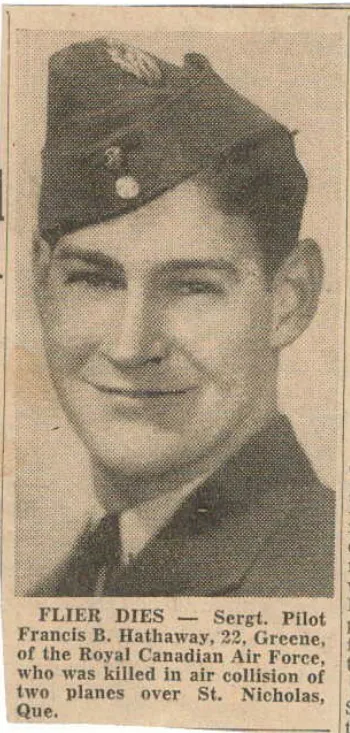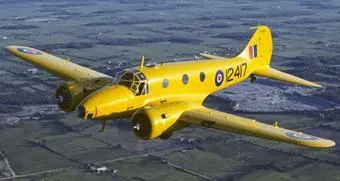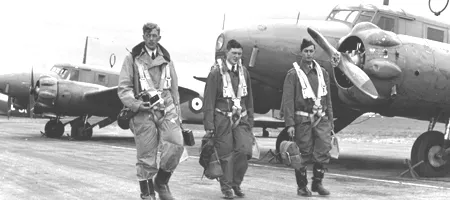Hathaway, Francis Raymond (Sergeant)
Killed in Flying Accident 1943-February-24


Birth Date: 1921
Born:
Parents: Son of J. Walter and Myrthe Hathaway; brother of Merlin W. Hathaway, of Whitney Point.
Spouse:
Home: Whitney Point, New York, USA
Enlistment:
Enlistment Date: unkown date
Service
RCAF
Unit
8 AOS- Air Observer School
Base
Ancienne Lorrette, Quebec, Canada
Rank
Sergeant
Position
Pilot
Service Numbers
R/125758
This incident involved multiple aircraft:
- Anson Mk. I Serial: DG893
- Anson Mk. I Serial: 6479
All the above aircraft in the above list are referenced in this report.
Crew or Other Personnel
Anson DG893
Anson serial: DG893

Canadian Warplane Heritage Museum
The Museum's Anson Mk. V was built by MacDonald Brothers in Winnipeg in 1944. It flew with No. 7 Photographic Wing and No. 414 Squadron in Ottawa on photo survey work until the late 1940s. In 1956, it was purchased by INCO and used for mineral surveying until 1980, when it was donated to the Museum. The exterior is painted in the yellow colour common to all BCATP trainers and is in its same wartime RCAF markings.
The Avro Anson was known by a number of nicknames including "Faithful Annie" or "Flying Greenhouse". It was the first aircraft to be flown by the Royal Canadian Air Force to have a retractable undercarriage, which was a comparative novelty in 1936. In 1940, a Canadian government owned company, Federal Aircraft Limited, was created in Montreal to manufacture the Anson for Canadian use. Nearly 3,000 Anson aircraft were produced and, in the early days of the British Commonwealth Air Training Plan (BCATP), the Anson was the standard trainer for many pilots, observers (navigators), wireless operators and bomb aimers. More than 20,000 aircrew received training on the Anson. In Canadian service, the aircraft was substantially re-designed with the substitution of North American engines and many other airframe and equipment changes. Harold Skaarup web pages
Aircraft Images
Anson DG893
Anson Mk. I DG893
1942-03-09 Taken on Strength 2022-02-07
1943-February-24 Accident: 8 Air Observer School Loc: St Nicholas Names: Beck | Hathaway | Spurr
1943-05-03 Struck off Strength 2022-02-07
Anson 6479
Anson Mk. I 6479
Ex RAF W2120. To No. 3 Training Command on 7 May 1941, for use by No. 8 Service Flying Training School at Moncton, NB. To No. 1 Training Command at RCAF Station Trenton on 28 May 1941. Back to No. 3 Training Command on 20 September 1943, for use by No. 8 Air Observers School at Ancienne Lorette, Quebec. Category A crash at St. Nicholas, Quebec on 24 February 1943.1941-04-17 Taken on Strength de Havilland Canada 2019-08-20
1943-February-24 Accident: 8 Air Observer School Loc: St Nicholas Names: Beck | Hathaway | Spurr
1943-05-03 Struck off Strength 2019-08-20
Unit Desciption
8 AOS (8 Air Observer School)
Air Observers were later called "navigators". For recruits in this stream, the training path after ITS was 8 weeks at an Air Observer School (AOS), 1 month at a Bombing & Gunnery School, and finally 1 month at a Navigation School. The Air Observer schools were operated by civilians under contract to the RCAF. For example, Nos. 7, 8, and 9 were run by CP Airlines. However, the instructors were RCAF. The basic navigation techniques throughout the war years were dead reckoning and visual pilotage, and the tools were the aeronautical chart, magnetic compass, watch, trip log, pencil, Douglas protractor, and Dalton Navigational Computer. They trained in the Avro Anson.
RCAF.info - RCAF Station L'Ancienne Lorrette QC